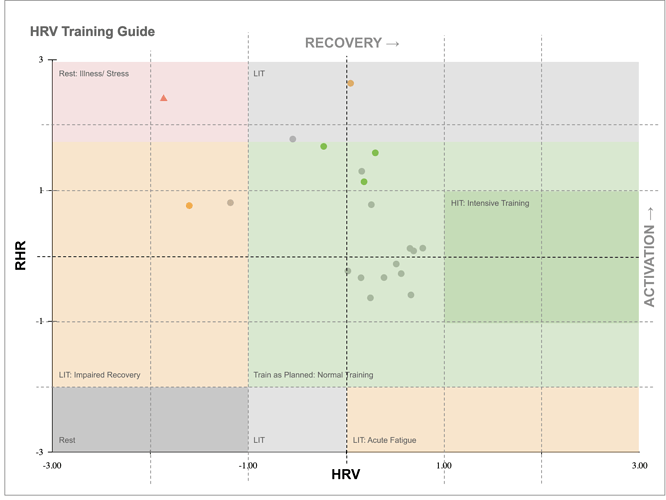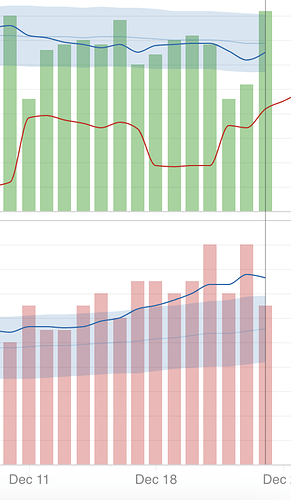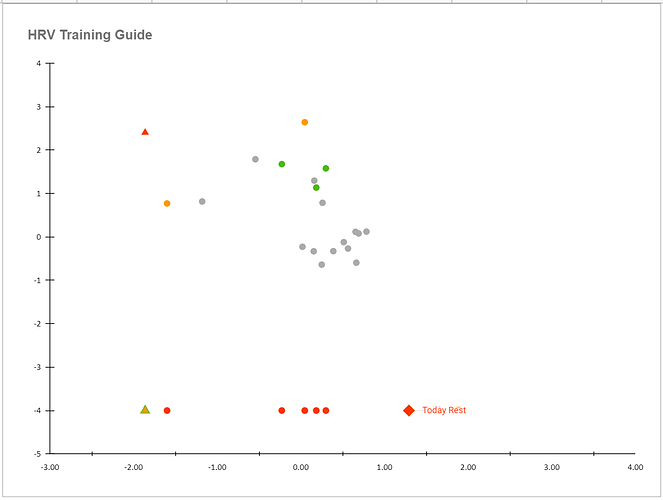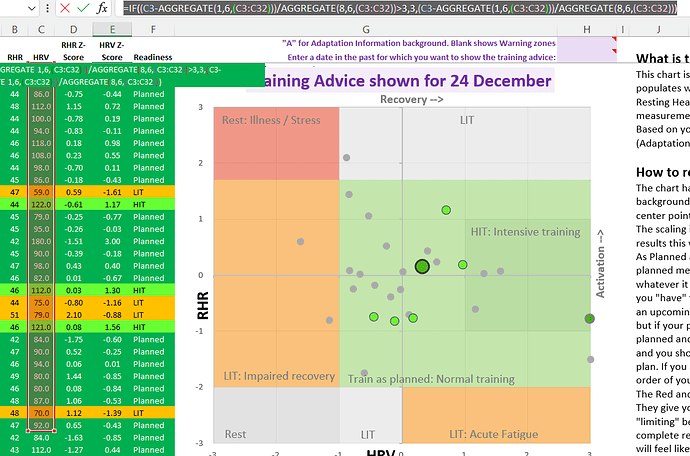The first post can be used to keep the latest version.
Once you make a change, I’ll copy the link and keep it current in the first post.
You will have to update it soon and with a very good surprise.
Intriguing 
On the Google Sheet, today I have no guidance - data is being pulled in.
I have been sick (which the system correctly identified), the numbers are now bouncing back.
It appears in the sheet that there are some calcs of -4 which then don’t appear on the graph, is this a bug or just the numbers are too wacky to be worth plotting?
I went back through old dates on the excel tracker a few weeks ago. One day last year I was sick, with HRV so low and HR so high it couldn’t plot a point on the graph that day  I was so far off the top left of the graph it didn’t register a guidance point
I was so far off the top left of the graph it didn’t register a guidance point
There is a bug in the Google sheets version explained here
Use the brand new MatLab version, you will not be dissapointed.
If I adjust the graph axis, there is a plot point. I guess too far outside of the “norms” that it doesn’t make sense. If I look at the axis limits on the Matlab version it would also not plot a point here (assuming it has the same math?)
That is the bug in the Google sheets version I think. Once you refresh the sheet without data for that day, you get -4.
What are the Z-scores on the HRV tab for those days? If they are within +/-3, they should plot normally in the Excel and Matlab version.
OK thank, they’re ok

I only have excel on my work PC so the Google Sheets version suits for use everywhere, I guess unless it works ok in OneDrive / Office365
To eliminate the off chart numbers, the formula can be changed to include =if((formulae)>3,3,(formula))
This way, all off the chart data is limited to the highest value on the axis.
Image added.
To copy the formula, simply copy and paste the text below
=IF((C3-AGGREGATE(1,6,(C3:C32)))/AGGREGATE(8,6,(C3:C32))>3,3,(C3-AGGREGATE(1,6,(C3:C32)))/AGGREGATE(8,6,(C3:C32)))
Training Plan, HRV scores, Subjective feelings … Bringing it all together:
Very nice and easy to understand article on how to use your data in the correct way.
Looks very similar to what I wrote in the chart explanation in the Excel file. Not to say that I came to this conclusion myself, I rather made an overview at that time, from all I read and attempted to bring it all together in an easily to digest format
Can I ask a question about this graphic please, just to help me understand it better (or rather confirm my understanding of it)
- The increasing/decreasing arrows - Is this the 7d base v the normalised 60d band?
- What SD do we use to calculate the CV% normalised band and over what duration?
- Is there ever any value to comparing a daily value to a 7 day normalised band?
- Is subjective feeling feedback the most important ‘metric’ of all? - If you have experienced a little bump in HRV + SDNN (v 60d normalised) coupled with a little drop in rHR (but still well within 30 normalised), sustained over 4 or 5 days and you feel absolutely great and perceived exertion is down for a given effort, can you still assume everything is OK and continue as normal?
- The arrows indicate the direction of the 7d trend. The three uses of ‘above 60d’ or ‘below 60d’ indicate that 7d is above or below the 60d.
- 7d CV. No SD band.
- Daily HRV values, like daily rHR and RR, can indicate acute situations. So, yes.
- IMHO, yes. No instrument samples as often nor processes as quickly as the body. Learning how to listen very sensitively and understand one’s own patterns is hugely beneficial. However, it’s still posibble to be caught out. (I experienced parasympathetic hyperactivity last fall and it was the darndest thing. Everything said go, including my subjective feeling. What I missed was that everything was too good for too long.)
Thanks!
Very interesting on your last point there.
It’s a similar scenario that prompted my questions really.
I definitely experienced it before myself and then came a crashing down:joy:. I want to avoid it again. There’s a difference between now and before though. No watery eyes this time 


Found an article from Marco Altini re parasympathetic saturation.
Is this graphic correct?
Parasympathetic saturation refers to a situation in which parasympathetic activity is particularly high, but this is not reflected accurately in HRV data .
However, if you are in a period of high training load and HRV is low, together with low HR , and therefore the correlation between HRV and the average RR interval length is small or negative (we lose the linear relationship that we were just discussing), parasympathetic saturation is plausible
Is PS hyperactivity the same as PS saturation as defined by Altini in the above link? Id so does that graphic need to be changed do put a decreasing arrow for HRV 7 day average for PS hyperactivity?
I might me misinterpreting this, so open to correction…
Parasymp. Stauration is not the same thing as Parasymp. Hyperactivation.
More info here:
Thanks. I suspected as much!!
Not a Garmin fan boy. Actually was very sceptical and main reason to buy a garmin watch was easy intervals.icu sync but here is a graph of my last 3 months of training (3x3weeks blocks with one week reco@1/2 of load) and you can clearly see how well it shows my hrv trends overlapping my training load. Just another argument for looking at hrv mostly from a weekly/monthly perspective at least.
I’ve looked at my connect profile and can’t find these HRV graphs - is it on the web or in the app? Thanks!
this one is from the web (training status tab), you can find them on app but they are not together, hrv is under hrv tab and load is under training status tab







